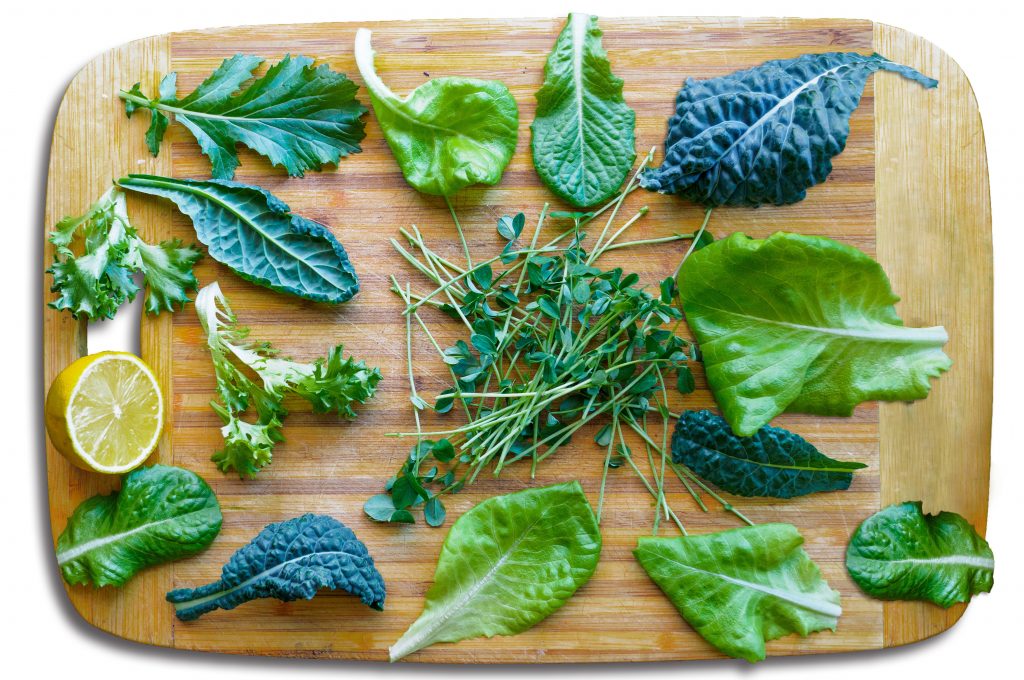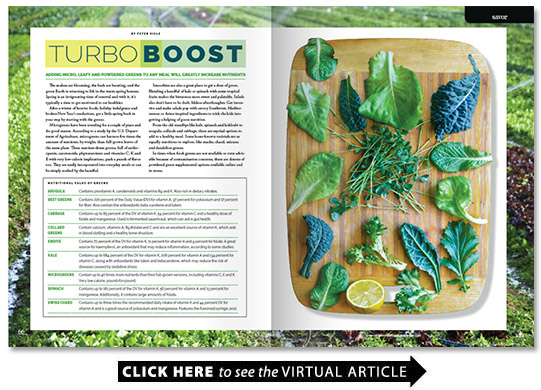

Adding micro, leafy and powdered greens to any meal will greatly increase nutrients
The azaleas are blooming, the buds are bursting, and the green Earth is returning to life in the warm spring breezes. Spring is an invigorating time of renewal and with it, it’s typically a time to get motivated to eat healthier.
After a winter of heavier foods, holiday indulgence and broken New Year’s resolutions, get a little spring back in your step by starting with the greens.
Microgreens have been trending for a couple of years and for good reason. According to a study by the U.S. Department of Agriculture, microgreens can harness five times the amount of nutrients, by weight, than full-grown leaves of the same plant. These nutrient-dense greens, full of anthocyanin, carotenoids, phytonutrients and vitamins C, K and E with very low-calorie implications, pack a punch of flavor too. They are easily incorporated into everyday meals or can be simply noshed by the handful.
Smoothies are also a great place to get a dose of green. Blending a handful of kale or spinach with some tropical fruits makes the bitterness more sweet and palatable. Salads also don’t have to be drab, lifeless afterthoughts. Get inventive and make salads pop with savory Southwest, Mediterranean or Asian-inspired ingredients to trick the kids into getting a helping of green nutrition.
From the old standbys like kale, spinach and kohlrabi to arugula, collards and cabbage, there are myriad options to add to a healthy meal. Some lesser-known varietals are as equally nutritious to explore, like mache, chard, mizuna and dandelion greens.
In times when fresh greens are not available or even advisable because of contamination concerns, there are dozens of powdered green supplemental options available online and in stores.
Nutritional Value of Greens
Arugula: Contains provitamin A, carotenoids and vitamins B9 and K. Also rich in dietary nitrates.
Beet Greens: Contains 220 percent of the Daily Value (DV) for vitamin A, 37 percent for potassium and 17 percent for fiber. Also contain the antioxidants beta-carotene and lutein.
Cabbage: Contains up to 85 percent of the DV of vitamin K, 54 percent for vitamin C and a healthy dose of folate and manganese. Used in fermented sauerkraut, which can aid in gut health.
Collard Greens: Contain calcium, vitamins A, B9 (folate) and C and are an excellent source of vitamin K, which aids in blood clotting and a healthy bone structure.
Endive: Contains 72 percent of the DV for vitamin K, 11 percent for vitamin A and 9 percent for folate. A great source for kaempferol, an antioxidant that may reduce inflammation, according to some studies.
Kale: Contains up to 684 percent of the DV for vitamin K, 206 percent for vitamin A and 134 percent for vitamin C, along with antioxidants like lutein and betacarotene, which may reduce the risk of diseases caused by oxidative stress.
Microgreens: Contain up to 40 times more nutrients than their full-grown versions, including vitamins C, E and K. Very low calorie, pound-for-pound.
Spinach: Contains up to 181 percent of the DV for vitamin K, 56 percent for vitamin A and 13 percent for manganese. Additionally, it contains large amounts of folate.
Swiss Chard: Contains up to three times the recommended daily intake of vitamin K and 44 percent DV for vitamin A and is a good source of potassium and manganese. Features the flavonoid syringic acid.
RECIPES
Tropical Green Smoothie
Servings: 4
Ingredients
1/2 cup kale
1/2 cup microgreens (any varietal)
1 package frozen acai
1/2 cup chopped dragonfruit (frozen or fresh)
1 1/2 cups coconut milk
1/2 cup chopped pineapple (frozen or fresh)
1/2 cup chopped mango (frozen or fresh)
Preparation
Add all ingredients to blender and blend until smooth.
Mediterranean Kale Salad
Servings: 4
Ingredients
1/2 lb. lacinto or “dinosaur” kale
1/4 lb. spinach or arugula
1 cup microgreens
1/2 cup crumbled feta cheese
1/4 cup crushed pita chips
1/4 cup chickpeas
1/8 cup chopped banana peppers
Preparation
Rough chop greens. Toss all remaining ingredients together in large bowl with dressing (recipe below).
Dressing:
1/2 cup extra virgin olive oil
1/4 cup red wine vinegar
1 tsp dijon mustard
1 tsp fresh lemon juice
1/2 tsp honey
1/4 tsp dried oregano
1/4 tsp dried basil
Pinch of sea salt
Pinch of black pepper
Blend all ingredients with immersion blender or with a whisk.
Microgreen & Pomegranate Blinis
Servings: 4
Ingredients
1 cup chickpea flour
1/2 tsp salt
1 cup water
2 tsp olive oil
Olive oil for frying
1 quart microgreens
1/2 cup pomegranate seeds
3/4 cup creme fraiche
1/8 cup basil
Pinch of sea salt to season
Preparation
Start by preparing the blinis. Whisk chickpea flour and salt in a large bowl. Add water and continue whisking until smooth. Whisk in the olive oil and let the batter rest for 30 minutes.
Turn stovetop on medium and brush a large frying pan with olive oil. Add 1 tablespoon of batter at a time to hot pan to make 2-inch blinis. Crisp on each side for 1 minute, like a pancake. Chiffonade basil into thin ribbons and gently blend into creme fraiche. To serve, top the blinis with a teaspoon of creme fraiche, then gently top with large pinch of microgreens and 1/2 teaspoon of pomegranate seeds to each blini. Season plate of completed blinis with sea salt.